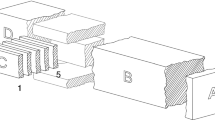Abstract
High alumina cement (HAC) concrete undergoes with ageing a change in mineral constitution known as conversion which may be accompanied by a loss in strength. The amount by which this change in composition has gone, measured by the ratio of CaO·Al2O3·10 H2O to Al2O3·3 H2O is known as the degree of conversion (D c ). The faster the conversion goes the greater the loss in strength.
Résumé
Le béton à haute teneur en alumine subit, au cours du vieillissement, un changement de constitution minérale. Ce phénomène, connu sous le nom de conversion, peut être accompagné d'une perte de résistance. La définition quantitative de ce changement, mesurée par le rapport CaO·Al2O3·10 H2O/Al2O3·3 H2O, est connue sous le nom de degré de conversion (D c ). Plus la conversion est rapide, plus les pertes de résistance sont notables.
Zusammenfassung
Beim Altern von Zement mit hohem Aluminiumoxidgehalt (HAC) treten Änderungen in der Mineralienkonstitution auf. Diese als Konversion bekannte Erscheinung kann mit Festigkeitsverlusten verbunden sein. Der Umfang dieser Veränderungen der Zusammensetzung wird an dem Verhältnis von CaO·Al2O3·10 H2O zu Al2O3·3 H2O gemessen und Konversionsgrad (D c ) genannt. Je schneller die Konversion, umso grösser die Verluste an Festigkeit.
Резюме
Бетон высоко глинозе мистого цемента при старении изменяется в минеральном составе, что известно как превращение, сопровождающееся по терей прочности. Степ ень, на которую протекало изменение состава, из мерялось отношением СаО·Аl2О3· 10Н2О к Аl2О3·ЗН2О, которо е известно как степен ь превращения (Дc). Более быстрое превращение приводи т к большей потере про чности.
Similar content being viewed by others
References
H. G. Midgley andA. Midgley, The conversion of high alumina cement, Magazine of Concrete Research, 27, 91 (1975) 59–77.
H. G. Midgley, The mineralogy of set high alumina cement, Trans Brit Ceram. Soc., 66, 4 (1967) 161–187.
F. W. Wilburn, C. J. Keattch, H. G. Midgley andE. L. Charsley, Recommendations for the testing of high alumina cement concrete samples by Thermoanalytical Techniques, Thermal Methods Group, Analytical Division of the Chemical Society, London, 1975, p. 1–11.
High alumina cement in buildings. Department of the Environment document BRS (1068) 2, dated 20. July 1974.
Author information
Authors and Affiliations
Additional information
The work described has been carried out as part of the research programme of the Building Research Establishment of the Department of the Environment and this paper is published by permission of the Director.
Rights and permissions
About this article
Cite this article
Midgley, H.G. The use of thermal analysis methods in assessing the quality of high alumina cement concrete. Journal of Thermal Analysis 13, 515–524 (1978). https://doi.org/10.1007/BF01912391
Received:
Issue Date:
DOI: https://doi.org/10.1007/BF01912391




